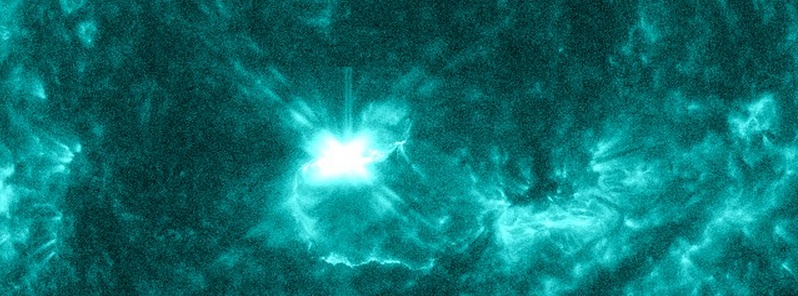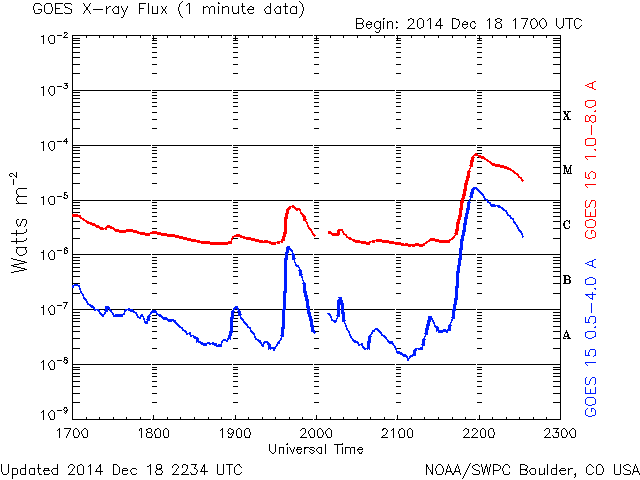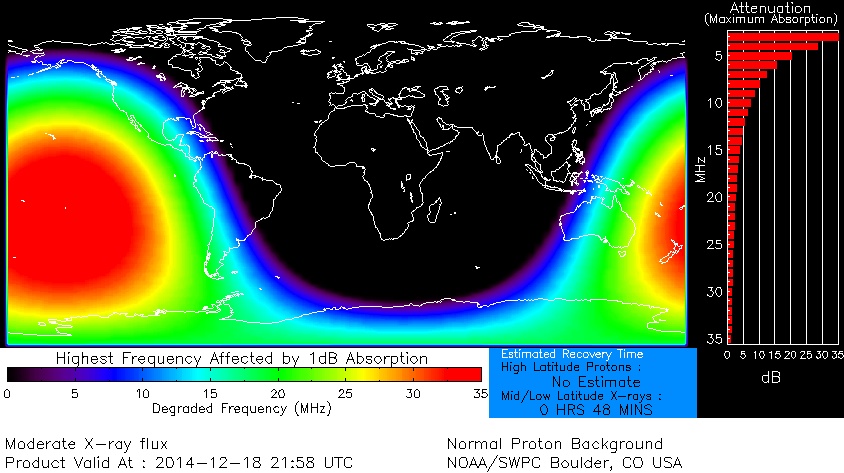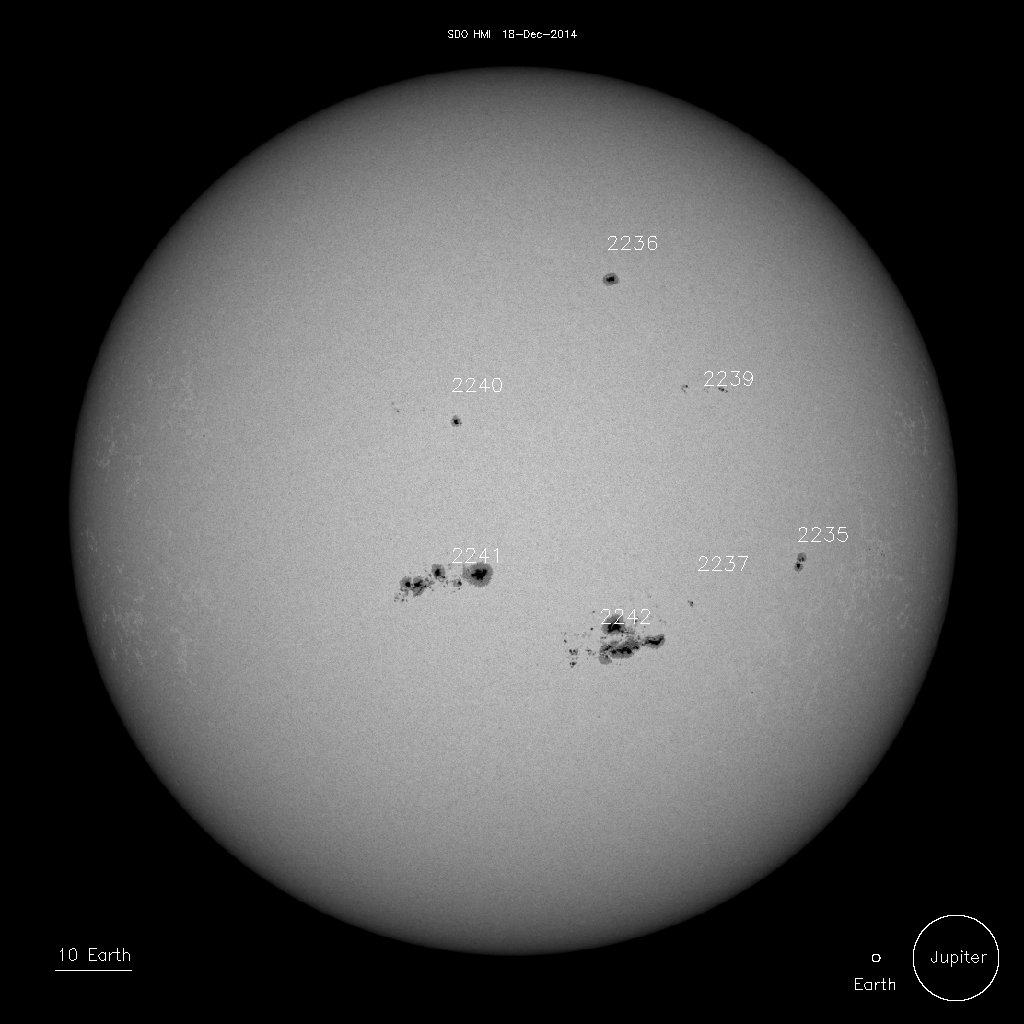Strong M6.9 solar flare erupts from geoeffective Region 2241

A strong solar flare measuring M6.9 (R2-Moderate Radio blackout) at its peak time erupted from geoeffective Active Region 2241 at 21:58 UTC on December 18, 2014. The event started at 21:41 and ended at 22:25 UTC.
This region is located at the center of the solar disk and has 'beta-gamma-delta' magnetic configuration, capable of producing more powerful flares. If Coronal Mass Ejection (CME) was produced by this event it will most likely have an Earth-directed component.
A Type II Radio Emission with estimated velocity of 664 km/s was associated with the event. Type II emissions occur in association with eruptions on the Sun and typically indicate a CME is associated with a flare event.
Additionally, a 10cm Radio Burst (TenFlare) lasting 14 minutes, with peak flux of 240 sfu was observed. A 10cm radio burst indicates that the electromagnetic burst associated with a solar flare at the 10cm wavelength was double or greater than the initial 10cm radio background. This can be indicative of significant radio noise in association with a solar flare. This noise is generally short-lived but can cause interference for sensitive receivers including radar, GPS, and satellite communications.
An asymmetric full halo CME was first observed in SOHO/LASCO C3 imagery at 01:04 UTC on December 19. There was a concurrent filament eruption off the SE limb during this time and imagery gaps preclude the differentiation of the two events.
Solar activity is expected to be at moderate (R1-R2/Minor-Moderate) levels for the next three days (December 18 – 20) as Regions 2241 and 2242 continue to grow in areal coverage. There is also a chance for an isolated X-class event (R3-Strong) during the same period.

Serial Number: 132
Issue Time: 2014 Dec 18 2242 UTC
SUMMARY: X-ray Event exceeded M5
Begin Time: 2014 Dec 18 2141 UTC
Maximum Time: 2014 Dec 18 2158 UTC
End Time: 2014 Dec 18 2225 UTC
X-ray Class: M6.9
Optical Class: 2n
Location: S11E10
NOAA Scale: R2 - Moderate
Comment: Optical class is preliminary.
NOAA Space Weather Scale descriptions can be found at
www.swpc.noaa.gov/noaa-scales-
Space Weather Message Code: ALTTP2
Serial Number: 989
Issue Time: 2014 Dec 18 2258 UTC
ALERT: Type II Radio Emission
Begin Time: 2014 Dec 18 2222 UTC
Estimated Velocity: 664 km/s
NOAA Space Weather Scale descriptions can be found at
www.swpc.noaa.gov/noaa-scales-
Space Weather Message Code: SUM10R
Serial Number: 651
Issue Time: 2014 Dec 18 2227 UTC
SUMMARY: 10cm Radio Burst
Begin Time: 2014 Dec 18 2150 UTC
Maximum Time: 2014 Dec 18 2156 UTC
End Time: 2014 Dec 18 2204 UTC
Duration: 14 minutes
Peak Flux: 240 sfu
Latest Penticton Noon Flux: 213 sfu
NOAA Space Weather Scale descriptions can be found at
www.swpc.noaa.gov/noaa-scales-

Sunspots
There are currently 9 numbered sunspot regions on the solar disk.
Region 2241 ('beta-gamma-delta') continues to show growth and it maintained its delta magnetic configuration across an east-west polarity inversion line during last 24 hours. Region 2242 ('beta-gamma-delta') also continued to exhibit growth in its overall areal coverage and maintained its delta magnetic configuration during the same period.
The remaining regions on the visible disk are stable and mostly inactive.

Sunspots on December 18, 2014. Image credit: NASA SDO/HMI
2230 – Alpha
2234 – Alpha
2235 – Beta
2236 – Beta
2237 – Alpha
2239 – Beta
2240 – Beta
2241 – Beta-Gamma-Delta
2242 – Beta-Gamma-Delta
Geospace forecast
The geomagnetic field is expected to be quiet to unsettled (below G1-Minor) for the majority of December 18 and 19.
Unsettled to active conditions are expected to begin late on December 19, with a chance for isolated minor storm periods (G1-Minor) due to the arrival of the CME associated with the M8.7 flare observed on December 17.
Featured image: NASA SDO/AIA 131 at 21:57 UTC on December 18, 2014.

Commenting rules and guidelines
We value the thoughts and opinions of our readers and welcome healthy discussions on our website. In order to maintain a respectful and positive community, we ask that all commenters follow these rules:
We reserve the right to remove any comments that violate these rules. By commenting on our website, you agree to abide by these guidelines. Thank you for helping to create a positive and welcoming environment for all.